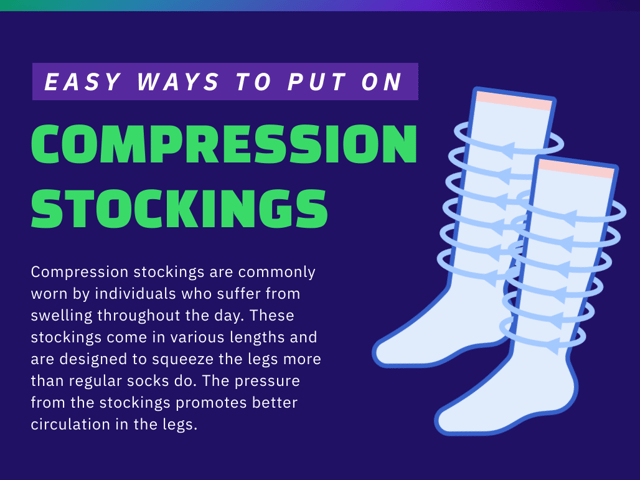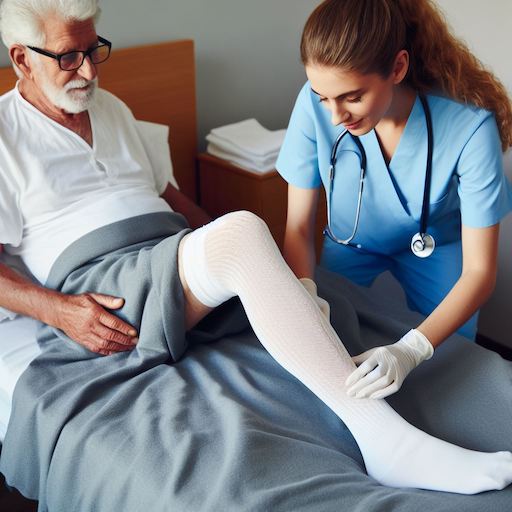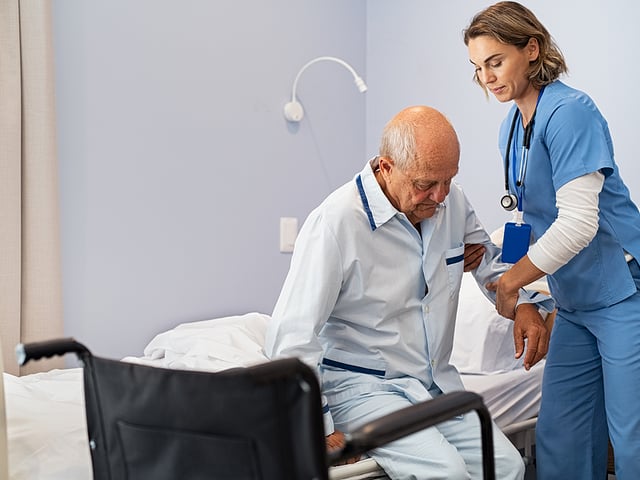
Easy Ways to Put On Compression Stockings
Compression stockings are a crucial tool used in the healthcare industry to aid patients suffering from frequent leg swelling or those prone to venous disorders like edema, phlebitis, and thrombosis. They exert more pressure on the legs than regular socks, thereby facilitating superior blood circulation. However, due to their snug fit, putting these stockings on a patient can present a challenge. Here are a few strategies that Certified Nursing Assistants (CNAs ) can employ to effectively assist patients with this task:
Preparatory Procedure: Elevate Patient’s Legs
To begin, have the patient to lie down, a posture that promotes relaxation and eases the task of elevation.
Once the patient is comfortably positioned, the next step is to elevate their legs. This can be accomplished by placing a cushion, pillow, or foam wedge under their ankles and calves, ensuring that the legs are higher than the level of the patient’s heart. It’s also important to make sure that the method of elevation provides the patient with comfort and doesn’t put any strain on their joints.
The legs should remain elevated for approximately 15 minutes. This duration may vary based on the patient’s condition and the level of swelling, but 15 minutes is generally a good starting point. The principle behind this approach lies in utilizing gravity to facilitate the movement of accumulated fluid away from the lower extremities and back towards the heart, thereby reducing swelling.
This preparatory step has a dual benefit. Firstly, by decreasing the swelling in the patient’s legs and feet, it can make the tight compression stockings easier to slide on. Secondly, it helps improve the patient’s comfort, as the stockings can feel less restrictive on legs with reduced swelling.
It’s important to communicate effectively with the patient during this procedure. Make sure to explain the reason behind the elevation and reassure them about its benefits. This can not only make the patient more cooperative but also provide them with a better understanding of their care.
Donning Technique: Bunch and Gradually Pull Up
The “Bunch and Pull Up in Sections” method is an efficient strategy when putting compression stockings on a patient’s legs. This process involves folding the stocking upon itself and then carefully and slowly unravelling it up the patient’s leg. This technique not only eases the process of wearing tight stockings but also ensures an even distribution of compression, an essential factor in their effectiveness.
The process begins by turning the stocking inside out until the heel pocket is exposed. Now hold onto the heel area, and gather or ‘bunch’ the rest of the stocking, folding it over the hand holding the heel. The stocking should now be inside out with the toe area easily accessible.
You then carefully place the patient’s foot, ensuring that the toes and heel align correctly with the designated areas on the stocking. This can often be the most challenging part, as the stocking material is designed to fit snugly and may resist initial attempts to fit the foot. Patience and gentle, persistent maneuvering can help overcome this hurdle.
Once the foot is correctly positioned, you slowly begin to ‘unravel’ the stocking up the leg. The unravelling should be done in sections to ensure that the stocking fits smoothly and comfortably. Start from the ankle, then move on to the calf, and finally, if you’re applying a thigh-length stocking, proceed to the thigh area.
As you pull up the stocking, make sure to continually smooth out the fabric. This is crucial because creases or bunched up material can lead to areas of excessive pressure. These ‘pressure points’ not only cause discomfort and potential skin damage but also interfere with the even distribution of compression, undermining the stocking’s effectiveness.
It’s important to encourage patient participation as much as possible in this process, guiding them to help smooth the fabric and adjust for comfort. This inclusion not only improves patient autonomy and engagement but also aids in their understanding of the process, which can be beneficial if they have to apply the stockings independently in the future.

Skin Care: Apply Moisturizer and Safe Body Powder
Proper skin care plays a pivotal role in easing the process of donning compression stockings for patients. Not only does it make the application smoother, but it also helps prevent skin irritations that might result from the prolonged wearing of these stockings. Effective skin care can involve the application of moisturizers and the use of safe body powder.
Applying a moisturizer to the patient’s skin, specifically the legs, can greatly enhance skin hydration, leaving it soft and supple. It’s generally recommended to apply the lotion at night, allowing it to be absorbed thoroughly by the skin overnight. This practice ensures that the patient’s skin remains well-hydrated and less prone to dryness and irritation when the stockings are worn in the morning.
However, applying lotion immediately before attempting to put on the compression stockings in the morning might make the skin slippery, complicating the donning process. Therefore, it’s best to ensure a time gap between moisturizing and wearing the stockings.
In addition to moisturizing, dusting the patient’s legs and ankles with a safe body powder can be beneficial. The body powder acts as a sort of ‘lubricant’, reducing friction between the stocking material and the patient’s skin. This allows the compression stockings to glide more smoothly up the patient’s leg, easing the process of application.
When choosing a body powder, it’s essential to consider the patient’s skin sensitivity and potential allergic reactions. Opt for powders that are free from potentially irritating substances like fragrances and dyes, particularly if the patient has sensitive skin. Talcum powders have traditionally been used, but some concerns have been raised about their safety. As an alternative, consider cornstarch-based powders or those specially designed for sensitive skin.
Utilize Tools: Donning Tools and Gloves
When traditional strategies of putting on compression stockings are challenging, utilizing specialized tools like stocking applicators and gloves can significantly streamline the process. These tools are specifically designed to aid in the application of compression stockings, making them valuable resources for CNAs in ensuring patient comfort and care.
Donning tools, also known as stocking applicators, come in various designs to cater to different needs. For instance, there are metal frame applicators and plastic sliding devices. The metal frame applicators hold the stocking open while the patient inserts their foot and pulls the device up to unroll the stocking onto the leg. The plastic sliding devices work similarly but are designed to reduce friction between the stocking and the skin, making the application smoother.
These tools can be particularly useful when assisting patients with mobility issues, as they reduce the physical strain on the patient. They also minimize the need for the patient to bend or reach, which can be challenging for individuals with restricted mobility due to conditions such as arthritis or obesity.
On the other hand, donning gloves are a simpler, yet highly effective tool. Made from rubber or similar materials, these gloves provide a better grip on the stocking material compared to bare hands. They make it easier to adjust the stockings, especially during the “bunch and pull” process, without risking damage to the stocking material. Additionally, they protect the stockings from oils and dirt on the caregiver’s hands that can deteriorate the material over time.
The gloves also provide a protective barrier for the caregiver’s hands, minimizing the risk of fingernail cuts or snags to the stocking material. Furthermore, the enhanced grip allows for a smoother, more controlled pull up the leg, reducing the risk of uneven pressure points or creases in the stockings.
Wrapping Up: Optimizing the Use of Compression Stockings in Patient Care
In conclusion, while the process of assisting a patient with donning compression stockings can be challenging, the use of donning tools and gloves can significantly simplify this task. By incorporating these strategies and tools, CNAs can ensure that their patients reap the full benefits of compression therapy, thereby aiding their recovery or maintaining their comfort in cases of chronic conditions.

Keep Reading

Certified Nursing Assistant Exam Blog
How Long Does it Take to Become a CNA?
As a profession on the frontline of healthcare, Certified Nursing Assis…

Certified Nursing Assistant Exam Blog
How to Do Well on the CNA Skills Test
Over 1.3 million nursing assistants work in our healthcare system today…

Certified Nursing Assistant Exam Blog
What Does a Nursing Assistant (CNA) Do?
Are you interested in exploring medical careers? The healthcare industr…